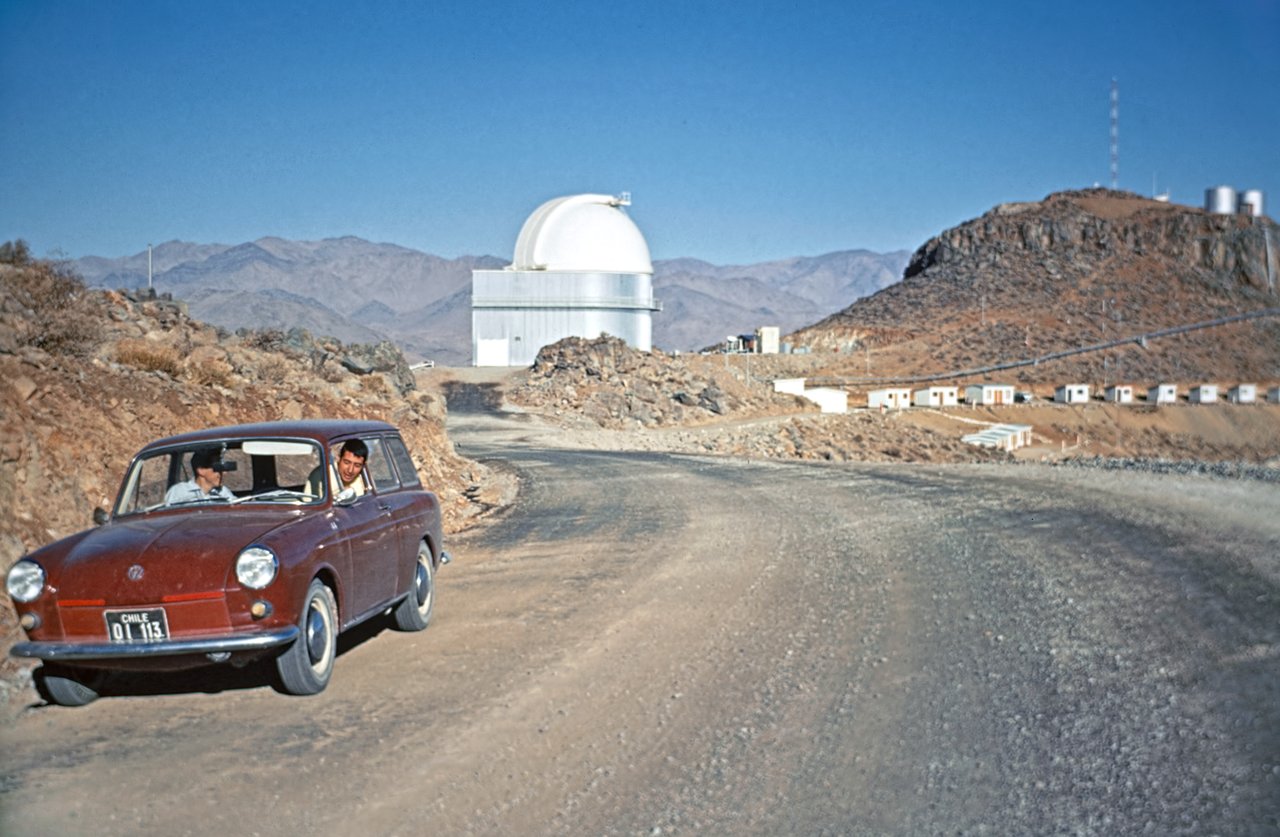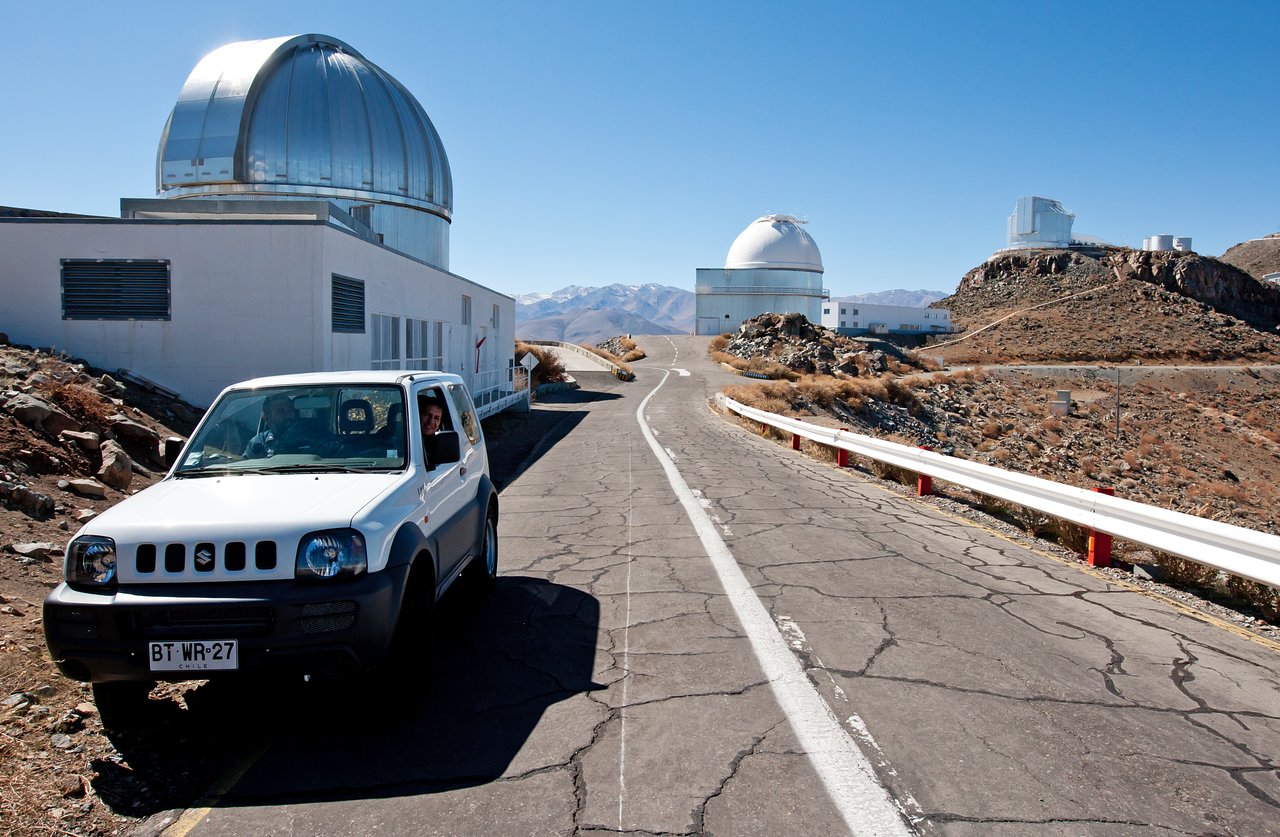Un voyage à travers le temps, comment les télescopes, et voitures ont changés à La Silla


L'ESO a cinquante ans cette année, pour célébrer cet anniversaire important nous allons vous montrer des morceaux de notre histoire. Une fois par mois durant 2012, une Photo de la Semaine comparant le Passé et le Présent montrera comment les choses ont changé durant les décennies au observatoires de La Silla et de Paranal, les installations ESO à Santiago du Chili et le Siège Social à Garching / Munich, Allemagne.
Ces deux photos montrent l'observatoire de La Silla en 1960 et de nos jours. On peut examiner les différence entre les deux photos avec cette comparaison. Les télescopes sont les seuls choses qui ont changé, les voitures dans les photos montrent également le temps qui s'est écoulé. La Volkswagen 1 Variant dans la première image a été remplacée dans la seconde image par une Suzuki 4WD. De nos jours, tout les véhicules ESO à La Silla sont blancs pour ameliorer la visibilité de nuit.
Le télescope se trouvant seul au centre de l'image historique est le télescope ESO "Schmidt" de 1 mètre, commençant à observer en 1971. Il utilisait des assiettes photographiques pour prendre des images grand champ du ciel austral, qui pouvait contenir 64 fois la pleine Lune. Les bâtiments longeant la droite de l'image sont les endroits où les astronomes avaient l'habitude de dormir.
De nos jours, deux autres télescopes sont apparus. Sur la gauche se trouve le télescope MPG/ESO de 2.2 mètres, en service depuis 1984. En fait, l'image actuelle n'a pas pu être prise au même endroit que l'image historique car sinon il aurait bloqué la vue! Sur le sommet à droite se trouve le New Technology Telescope (NTT) mis en service en 1989. Ces deux télescopes ont eu d'énormes succes au cours des années et sont encore exploités. Les logements des astronomes ont été remplacés par un "hôtel" plus confortable sur le bord du site.
Pour ce qui est du télescope Schmidt, se trouvant encore au milieu, son appareil photo a été démantelé en Décembre 1998, mais il vit encore en tant que télescope de projet. Il est utilisé pour le LaSilla-QUEST Variable Survey: une recherche pour des objets transitant dans le ciel austral, tel que des planètes naines de la taille de Pluto ou des supernovas. Son nouvel appareil photo a une mosaïque de 112 CCD, avec un total de 160 millions de pixels, un excellent exemple de comment la nouvelle technologie peut permetrre une seconde vie aux vieux télescopes!
Links
- L'image historique
- L'image actuelle
- Plus sur La Silla
- Communiqué de presse à l'occasion du 40ème anniversaire, en 2009, de l'inauguration de La Silla
- Le timeline de l'ESO
Crédit
ESO
À propos de la comparaison d'images
| Identification: | potw1206a |
| Date de publication: | 6 février 2012 10:00 |
Images
Our use of Cookies
We use cookies that are essential for accessing our websites and using our services. We also use cookies to analyse, measure and improve our websites’ performance, to enable content sharing via social media and to display media content hosted on third-party platforms.
ESO Cookies Policy
The European Organisation for Astronomical Research in the Southern Hemisphere (ESO) is the pre-eminent intergovernmental science and technology organisation in astronomy. It carries out an ambitious programme focused on the design, construction and operation of powerful ground-based observing facilities for astronomy.
This Cookies Policy is intended to provide clarity by outlining the cookies used on the ESO public websites, their functions, the options you have for controlling them, and the ways you can contact us for additional details.
What are cookies?
Cookies are small pieces of data stored on your device by websites you visit. They serve various purposes, such as remembering login credentials and preferences and enhance your browsing experience.
Categories of cookies we use
Essential cookies (always active): These cookies are strictly necessary for the proper functioning of our website. Without these cookies, the website cannot operate correctly, and certain services, such as logging in or accessing secure areas, may not be available; because they are essential for the website’s operation, they cannot be disabled.
Functional Cookies: These cookies enhance your browsing experience by enabling additional features and personalization, such as remembering your preferences and settings. While not strictly necessary for the website to function, they improve usability and convenience; these cookies are only placed if you provide your consent.
Analytics cookies: These cookies collect information about how visitors interact with our website, such as which pages are visited most often and how users navigate the site. This data helps us improve website performance, optimize content, and enhance the user experience; these cookies are only placed if you provide your consent. We use the following analytics cookies.
Matomo Cookies:
This website uses Matomo (formerly Piwik), an open source software which enables the statistical analysis of website visits. Matomo uses cookies (text files) which are saved on your computer and which allow us to analyze how you use our website. The website user information generated by the cookies will only be saved on the servers of our IT Department. We use this information to analyze www.eso.org visits and to prepare reports on website activities. These data will not be disclosed to third parties.
On behalf of ESO, Matomo will use this information for the purpose of evaluating your use of the website, compiling reports on website activity and providing other services relating to website activity and internet usage.
Matomo cookies settings:
Additional Third-party cookies on ESO websites: some of our pages display content from external providers, e.g. YouTube.
Such third-party services are outside of ESO control and may, at any time, change their terms of service, use of cookies, etc.
YouTube: Some videos on the ESO website are embedded from ESO’s official YouTube channel. We have enabled YouTube’s privacy-enhanced mode, meaning that no cookies are set unless the user actively clicks on the video to play it. Additionally, in this mode, YouTube does not store any personally identifiable cookie data for embedded video playbacks. For more details, please refer to YouTube’s embedding videos information page.
Cookies can also be classified based on the following elements.
Regarding the domain, there are:
- First-party cookies, set by the website you are currently visiting. They are stored by the same domain that you are browsing and are used to enhance your experience on that site;
- Third-party cookies, set by a domain other than the one you are currently visiting.
As for their duration, cookies can be:
- Browser-session cookies, which are deleted when the user closes the browser;
- Stored cookies, which stay on the user's device for a predetermined period of time.
How to manage cookies
Cookie settings: You can modify your cookie choices for the ESO webpages at any time by clicking on the link Cookie settings at the bottom of any page.
In your browser: If you wish to delete cookies or instruct your browser to delete or block cookies by default, please visit the help pages of your browser:
Please be aware that if you delete or decline cookies, certain functionalities of our website may be not be available and your browsing experience may be affected.
You can set most browsers to prevent any cookies being placed on your device, but you may then have to manually adjust some preferences every time you visit a site/page. And some services and functionalities may not work properly at all (e.g. profile logging-in, shop check out).
Updates to the ESO Cookies Policy
The ESO Cookies Policy may be subject to future updates, which will be made available on this page.
Additional information
For any queries related to cookies, please contact: pdprATesoDOTorg.
As ESO public webpages are managed by our Department of Communication, your questions will be dealt with the support of the said Department.

